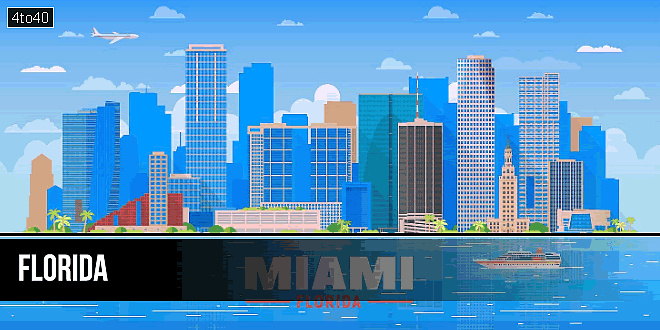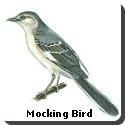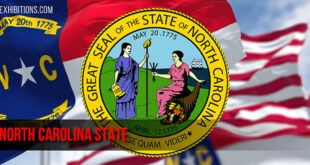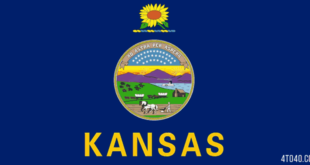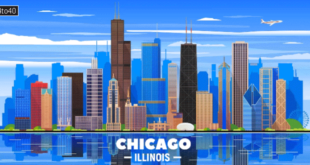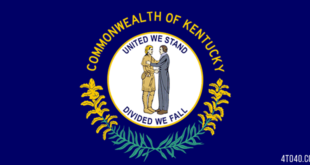Florida state, a favorite destination of millions of tourists, is a fast-developing state of the southeastern United States. Mostly a peninsula, Florida is bordered by Alabama and Georgia on the north, the Atlantic Ocean on the east, the Straits of Florida on the south, and the Gulf of Mexico and Alabama on the west. The first European to visit the region was the Spanish explorer Juan PONCE DE LEON in 1513, who called it Florida (“feast of flowers”), either because he saw a profusion of flowers on its coast or because it was Easter week (Pascua florida). The first permanent European settlement in the continental United States was at SAINT AUGUSTINE in 1565.
Florida State: Land & Resources
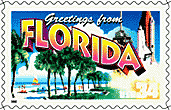
Florida is low-lying and level, with an average elevation of about 30 m (100 ft). The highest point, in Walton County in the northwest, is 105 m (345 ft) above sea level. Florida has 2,172 km (1,350 mi) of coastline, more than any other state except Alaska; 933 km (580 mi) of the coastline border the Atlantic, and 1,239 km (770 mi) border the Gulf of Mexico. The uneven coastline is indented with estuaries, bays, inlets, lagoons, and rivers. The FLORIDA KEYS, an arc of islands–mostly either uplifted coral reefs or limestone shoals–lie off the state’s southern tip.
Physiographic Regions:

The land area of Florida and its continental shelf make up the Florida Plateau, which separates the Atlantic Ocean from the Gulf of Mexico. Volcanic mountains buried during the Paleozoic Era (510 to 230 million years ago) form the base of the Florida Plateau. At present, these volcanic rocks are approximately 3,959 m (13,000 ft) below the surface of central Florida. Sands and other materials that were deposited on the base have formed sedimentary rocks more than 1,200 m (4,000 ft) thick. The plateau has shifted over the centuries, and it is now tilted from east to west, with the eastern part higher than the western part as evidenced by the gulf’s broad continental shelf. If the plateau were not tilted and the whole area were dry land, the state of Florida would be twice its present size.
The Florida Plateau is divided into five land regions–the coastal lowlands, the EVERGLADES, the central highlands, the northwestern highlands, and the Marianna lowlands. The coastal lowlands include the Atlantic and Gulf zones and contain 70% of Florida’s population. The Everglades were originally a sea bottom. As the area was raised, the Okeechobee Basin remained higher than the area to the south. Because Lake OKEECHOBEE is shallow, has low banks, and is in a wet region, water overflows to the south and southwest, creating a sea of water grasses, open water areas, cypress forests, and mangrove swamps. Human activities, however, have modified the water flow and changed the natural character of the Everglades. The central highlands, narrow in the south and wide in the north, are marked by sinkholes, lakes, and springs. A part of the OKEFENOKEE SWAMP is in the far north, astride the border with Georgia. West of the SUWANNEE RIVER are the northwestern highlands, with elevations rising above 91 m (300 ft) and deeply cut river valleys. The Marianna lowlands bisect the northwestern highlands.
Rivers and Lakes:
Because of Florida’s relatively flat topography, most of its rivers are slow-moving, and many overflow during periods of heavy rain and dry up in times of drought. The state’s longest river, the Saint Johns river, flows north from Indian River County to the Atlantic Ocean, near Jacksonville. Other major rivers include the Apalachicola, Kissimmee, Peace, Perdido, St. Marys, Suwannee, and Withlacoochee.
Florida’s groundwaters are primarily supplied by the Floridan aquifer, which extends across the entire state, except in the far west. Lake Okeechobee is the largest lake in the state and the fourth largest natural lake within the United States. Central Florida is the site of numerous sinkhole lakes.
Climate:
Florida’s climate is influenced by the state’s location, its peninsular shape, and its numerous inland water bodies. No place in the state is more than 110 km (70 mi) from open water. Winds that blow over the GULF STREAM (an ocean current known locally as the Florida Current) moderate the climate.
The Florida Keys have a tropical climate, with average temperatures ranging from 22 deg C (71 deg F) in January to 29 deg C (84 deg F) in July. Northern Florida has a subtropical to temperate climate; Tallahassee has average temperatures of 12 deg C (53 deg F) in January and 27 deg C (81 deg F) in July.
The southeastern coast and the northwestern panhandle receive an average of 1,626 mm (64 in) of precipitation each year. In north central Florida the average annual precipitation is approximately 1,321 mm (52 in). Thunderstorms occur frequently, especially in central Florida. Hurricanes usually develop in the Caribbean and the Atlantic in late summer and early fall and can cause severe damage if they strike Florida. Since 1900, more than 20 major hurricanes have hit Florida, mostly in the southern and panhandle areas of the state.
Vegetation and Animal Life:
About half of Florida’s land area is covered with forests, and more than 350 types of trees grow in the state. Common hardwoods include ash, hickory, magnolia, mahogany, and oak. Mangrove and cypress flourish in the southern swamplands, such as Big Cypress Swamp and the Everglades. Pines predominate in the north. Palm trees grow throughout most of the state. The swamplands are noted for their epiphytes (air plants), such as Spanish moss, nonparasitic plants that typically hang from trees (especially oak and cypress); tall saw grass is also common in these wet regions.
Florida has a great variety of wildlife. Large mammals include whitetail deer, black bears, bobcats, and a few cougars. Foxes, muskrats, otters, possums, rabbits, raccoons, and squirrels are abundant. Swamps provide a habitat for alligators. Game birds, such as wild turkeys and quail, and water birds, such as egrets, flamingos, gulls, herons, and pelicans, are found. Common freshwater fish species include black bass, bream, catfish, and trout; marine animals include barracuda, bonito, dolphins, mackerel, marlin, menhaden, black mullet, pompano, tarpon, crabs, shrimp, and large turtles.
Historical Sites:
Castillo de San Marcos National Monument contains a masonry fort, begun in 1672, built by the Spanish to protect Saint Augustine. De Soto National Memorial, near Bradenton, commemorates the landing (1539) of the Spanish explorer Hernando de Soto. Fort Jefferson National Monument, in the DRY TORTUGAS islands, is the site of an immense fortification that served as a Union military prison during the U.S. Civil War. Dade Battlefield, near Bushnell, is the site where U.S. troops were defeated (1835) by Indians at the start of the Second Seminole War.
Tourism in Florida:
Tourists in Florida spend billions of dollars each year in the state. The warm climate of southern Florida during the winter is a favorite attraction for vacationers from the northeastern United States and Canada. In addition to the many beach resorts on both coasts, points of interest include CAPE CANAVERAL, the site of the John F. KENNEDY SPACE CENTER; Walt Disney World/Epcot Center ( DISNEYLAND AND WALT DISNEY WORLD) and MGM Studios, and Universal Studios, near Orlando ; Cypress Gardens, near Winter Haven; Busch Gardens, in Tampa, containing a large zoo; and Everglades National Park. The state has many state parks and recreation areas.
Florida State: History
At the end of the last ice age, more than 10,000 years ago, Florida was inhabited by groups from the Caribbean and by Indians who had migrated from the north and northwest following the movement of large game animals. At the time of the first European contact in the early 16th century, four major Indian groups lived in what is now Florida: the APALACHEE in the northwest; the Calusa in the southwest; the Tequesta along the southeastern coast; and the Timucua in the north central region.
European Rule:
In 1513, Juan Ponce de Leon landed on the northeast Florida coast and claimed Florida for Spain. In 1521 he returned to found a colony, but was unsuccessful and was killed the same year. In 1528, Panfilo de NARVAEZ, another Spanish explorer, anchored in Tampa Bay and then traveled inland. In 1539, Hernando DE SOTO landed near Tampa Bay, exploring that area and then northern Florida. Another Spaniard, Tristan de Luna, attempted, with some 1,600 men and women, to establish a permanent colony on Pensacola Bay in 1559, but after two difficult years the settlement was abandoned.
In 1562 the French Huguenot leader Gaspard de COLIGNY commissioned Jean RIBAUT to found a colony in the territory, and in 1564, Ribaut’s aide, Rene de LAUDONNIERE, built Fort Caroline, near present-day Jacksonville. PHILIP II of Spain sent a military expedition, led by Pedro MENENDEZ DE AVILES, to destroy the French settlement. Arriving in 1565, Menendez established Saint Augustine and massacred the French; he captured Fort Caroline and founded another settlement there. The Spanish subsequently built forts and missions across northern Florida and around the southwestern coast. During the SEVEN YEARS’ WAR (1756-63) between Britain and France, Spain sided with France and lost Cuba in 1762. Under the terms of the peace treaty (1763), Spain traded Florida to Britain in exchange for Cuba.
Under British rule, Florida was divided into two separate colonies, East Florida and West Florida. During the American Revolution, Floridians remained loyal to Britain; but by the Treaty of Paris (1783), English hegemony in Florida was ended and the region was returned to Spain.
U.S. Acquisition:
During the WAR OF 1812, Britain used Pensacola as a naval base, but in 1814 it was captured by American troops. In 1819, Spain agreed to transfer Florida to the United States, which assumed control in 1821. Andrew Jackson served briefly as the provisional governor. In 1822, Florida was organized as a territory, and William P. Duval became governor; soon many settlers, including Indians, streamed into Florida from the North. Conflicts erupted with the Seminole Indians, who were defeated in the Second SEMINOLE WAR (1835-42). Some of the Seminole were removed to Oklahoma, and a small band migrated south to the Everglades.
Statehood:
Florida entered the Union as a slave state on Mar. 3, 1845. By 1860 the population was about 140,000, of whom 63,000 were black. Florida seceded from the Union on Jan. 10, 1861, and subsequently joined the Confederacy. Most of Florida’s coastal towns were captured by Union forces early in the war, but Tallahassee remained under Confederate control throughout the war. The Battle of Olustee, which took place in Florida on Feb. 20, 1864, was one of the last Confederate victories.
In 1868, after a new constitution guaranteeing blacks the right to vote had been adopted, the state was readmitted to the Union. Republicans held most important elected offices until 1876, when the Democrats returned to power.
An era of rapid economic growth began in the 1880s–great deposits of phosphate were discovered, citrus groves were planted, southern swamplands were drained and converted to farmland, and railroads and tourist facilities were constructed. Several entrepreneurs, notably Henry M. Flagler (1830-1913), Hamilton Disston (1844-96), and Henry B. Plant (1819-99), led Florida’s development.
The Modern Era:
During the early 1920s, Florida experienced a great land boom. Real estate prices rose spectacularly until 1926, when a combination of factors, especially the well-publicized opinion of respected financial experts that Florida land was vastly overpriced, led to a rapid and severe drop in values. Later in 1926, Miami, one of Florida’s chief boom cities (its population had grown from 1,681 inhabitants in 1900 to 69,754 in 1925), was badly damaged by a hurricane. The state’s economy had largely recovered by 1929, when the Great Depression began, resulting in a high unemployment rate and a depression of land values.
From 1920 to 1930, Florida’s population had grown by more than 50%, reaching about 1,468,000 inhabitants. Growth continued during the 1930s and accelerated in the 1940s, when war-related activities spurred additional development. By 1950, Florida had about 2,771,000 inhabitants, and during both the 1950s and ’60s its population grew by about 2 million persons. In the postwar period the tourist and retirement industries grew rapidly, as did commercial farming. The aerospace industry developed in association with the Cape Canaveral missile and space-flight center. Floridians adhered gradually to the 1954 U. S. Supreme Court decision outlawing segregated schools, and by the 1970s most public schools were integrated. In the 1970s laws were passed that ensured protection of the state’s natural areas. Thousands of Cuban refugees settled in Florida, especially in Miami, in the 1960s and again in 1980. During the 1980s, Florida’s economy became more like that of the rest of the nation, with a decrease in agriculture and an increase in the service sector. Ongoing growth in population has encouraged growth-management legislation relating to environmentally sensitive land and beaches. In August 1992, South Florida, especially the Homestead area, was devastated by hurricane Andrew; the storm killed 38 persons, and left 250,000 homeless. After an initially slow official response, the U. S. military began construction of temporary shelters.
Florida State: Land
- Area: 170,313 sq km (65,758 sq mi); rank: 22nd
- Capital: Tallahassee (1990 pop., 124,773)
- Largest city: Jacksonville (1990 pop., 672,971)
- Counties: 67
- Elevations: Highest–105 m (345 ft), in Walton County; lowest–sea level, at Atlantic coast
External Links:
Business Events Happening In Florida:
Exhibition Venues In Florida:
Florida State: State Symbols
Flag:
Statehood:
Mar. 3, 1845; the 27th state.
Nickname:
Sunshine State
Bird:
Tree:
Sabal Palmetto Palm
Flower:

 Kids Portal For Parents India Kids Network
Kids Portal For Parents India Kids Network
